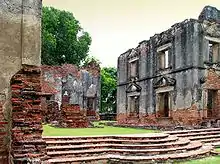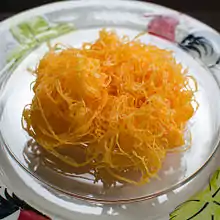Thao Thong Kip Ma Maria Guyomar de Pina | |
|---|---|
มารีอา กียูมาร์ ดึ ปีญา | |
| Born | 1664 |
| Died | 1728 (aged 63–64) |
| Nationality | Siamese |
| Occupation | cook |
| Spouse | |
| Children | Jorge Phaulkon (son) João Phaulkon (son) |
| Parents |
|
| Culinary career | |
| Cooking style | Portuguese-Siamese cuisine |
Maria Guyomar de Pina (Thai: มารีอา กียูมาร์ ดึ ปีญา; 1664 – 1728) (also known as Maria Guiomar de Pina, Dona Maria del Pifia or as Marie Guimar and Madame Constance in French), Thao Thong Kip Ma (Thai: ท้าวทองกีบม้า), was a Siamese woman of mixed Japanese-Portuguese-Bengali ancestry[1] who lived in Ayutthaya in the 17th century. She became the wife of Greek adventurer Constantine Phaulkon.[2]
Maria Guyomar is known in Thailand for having introduced new dessert recipes in Siamese cuisine at the Ayutthaya court. Some of her dishes were influenced by Portuguese cuisine, especially egg yolk-based sweets such as foi thong,[3] sangkhaya fakthong[4] and sangkhaya.
Biography

Maria was born in Ayutthaya during the reign of King Narai. Her father was known as Fanique or Phanick, a Mestiço from Goa of mixed Portuguese-Bengali-Japanese ancestry,[5] who was described as "half-black, half-Bengali, half-Japanese,"[6] a devout Catholic of little means.[7] Her mother was a Japanese Christian, named Ursula Yamada, whose ancestors had migrated to Siam following the repression of Christianity in Japan.[8] By some accounts, Ursula was not a very faithful wife and Maria, who was of light complexion, may have been fathered by a Sicilian priest.[7]
Maria Guyomar was brought up as a Catholic. In 1682, Maria married Constantine Phaulkon after he abandoned Anglicanism for Catholicism.[9] They had two sons, George "Jorge" Phaulkon and Constantin "João" Phaulkon, and lived a life of affluence as Phaulkon rose to become highly influential at the royal court of king Narai.
During the period of rapprochement between France and the Siamese court Maria Guyomar de Pinha, together with her husband Phaulkon, was promised French protection by being ennobled a countess of France. During the 1688 Siamese revolution, after the execution of her husband on 5 June, she managed to flee Ayutthaya with the help of a French officer named Sieur de Sainte-Marie and took refuge with the French troops in Bangkok on 4 October, but the Commander of the French fort General Desfarges returned her to the Siamese under pressure from the new ruler, usurper Phetracha, for the exchange of hostages on 18 October.[10]
Despite the promises that had been made regarding her safety, she was condemned to perpetual slavery in the kitchens of Phetracha[11] until his death in 1703, but remained and became the head of the royal kitchen staff.[12]
One of her sons, Jorge, became a minor official at the Siamese court. Her second son, João, was known to have been put in charge by Prince Phon of building a German organ for the royal palace.[13] According to French missionary sources he was called Racha Mantri and was at the same time a supervisor of the Christians in Ayutthaya and the official in charge of the royal storehouses.[14]
In her later life, Maria, together with her daughter-in-law Louisa Passagna (widow of João), continued to sue the French East India Company to recoup money which her husband Phaulkon had lent to the company. She was vindicated in 1717 through a decree from the Council of State in France, which provided her with a maintenance allowance.[13] Maria died in 1728.
Thai desserts

Maria Guyomar took the position of cook in the palace in the period of King Narai and introduced many new desserts into the Siamese cuisine such as curry puff, Khanom mo kaeng, Thong muan,[15] Thong yot, Thong yip, Foi thong, Sangkaya and Khanom phing.[16] Such desserts were presented and served to King Narai[17] and his daughter Princess Sudawadi who appreciated them and promoted them.[18] Khun Luang Ha Wat or King Uthumphon said that the desserts were distributed and sold in the market in area of Pa-Khanom.[19] Following the success of the new desserts in the palace, some nobles requested to be taught the recipes. Many of her desserts were yellow like gold, a colour that was considered auspicious and pleasant in Siamese tradition. Thus, the desserts that Maria had introduced were widely popularized.[20]
The Historical Archives of the Archdiocese of Bangkok mention that, although she introduced some local Siamese ingredients in them, Maria's sweets were largely based on traditional Portuguese desserts. The original Thai desserts had had flour, sugar or palm sugar and coconut as the main ingredients[19][21] and Maria is credited with having introduced egg or yolk, refined sugar, soybean starch or cassava starch, as well as nuts, in her desserts.[22] Angel hair or Fios de ovos, also known in Thai as Foi Thong, are egg threads where yolks were drawn into thin strands and boiled in sugar syrup. Next, Thong Yip, which is a sweet made from egg, was developed from Trouxa de ovos. They have a different external look, Thong Yip is pleated but Trouxa de ovos are rolled. Also, Khanom mo kaeng is a sweet made from flour egg and coconut milk, is similar to Tigelada, a Portuguese traditional sweet that has rolled almond as main ingredient.[22] During King Narai’s period, a version known as Khanom kumphamat (Thai: ขนมกุมภมาศ) was served to the king in a pot which was made from precious metal.[23]
There is, however, some disagreement over Maria’s role in popularizing the desserts, Pridi Phitphumwithi claimed that some of the kinds of dessert attributed to Maria had been previously known by Siamese people. They had been named “Convent sweet” because they were cooked by the nuns in Portuguese convents.[24] Other critics claim that even though a large array of Siamese desserts are claimed to have been invented by Maria, only two kinds of dessert —Foi thong and Thong yip— can be fully said to be the fruit of her own skill.[23]
Popular culture
The role of Maria Guyomar is featured in the 2018 historical drama TV series Love Destiny (original title Bupphesanniwat) and the 2023 historical drama TV series Love Destiny 2. She is portrayed by the Anglo-Thai actress Susira Naenna
See also
References
- ↑ Smithies 2002, p.100
- ↑ Keat Gin Ooi, Southeast Asia: A Historical Encyclopedia, from Angkor Wat to East Timor, page 1070.
- ↑ Joe Cummings, Thailand: World Food, Page 87.
- ↑ Van Esterik, Penny (2008). Food Culture of Southeast Asia. Greenwood Press. p. 71. ISBN 978-0-313-34419-0.
Some of the most famous Portuguese-Siamese desserts were attributed to Mary Gimard, or Thao Thong Giip Ma, the Portuguese-Japanese wife of Constance Phaulkon, the Greek adventurer who became Prime Minister under King Narai of Ayuttaya (1656–1688). She was credited with adapting Portuguese egg-based desserts into special royal desserts including a custard served in squash and a complex sweet made to look like mango seeds.
- ↑ Sitsayamkan 1967, cited in Byrne, John (2011). "The Luso-Asians and other Eurasians". Portuguese and Luso-Asian Legacies in Southeast Asia, 1511-2011: The making of the Luso-Asian world, intricacies of engagement. Institute of Southeast Asian Studies. p. 137. ISBN 9789814345255.
- ↑ Halikowski-Smith, Stefan (2011). Creolization and Diaspora in the Portuguese Indies. Brill. pp. 4–5, 120–121. ISBN 9789004190481.
- 1 2 Smithies, Michael (2000). "Madame Constance's Jewels" (PDF). Journal of the Siam Society. 88: 111–121.
- ↑ Sitsayamkan (1967), The Greek Favourite of the King of Siam, p. 17,
Her mother was a Japanese woman named Ursula Yamada, who came from a noted family which had emigrated from Japan. Her father was a Mr. Fanique. He was a dusky half-breed of Bengal and Japan.
- ↑ Smithies, p.183
- ↑ Smithies 2002, p.11/p.184
- ↑ Smithies 2002, p.51
- ↑ William D. Wray, The 17th-Century Japanese Diaspora: Questions of Boundary and Policy, History Department University of British Columbia, page 26. Archived 2010-06-16 at the Wayback Machine
- 1 2 Smithies 2002, p.180
- ↑ Dhivarat na Prombeja, in Reid, p.258
- ↑ Thong muan(crispy coconut rolls with sesame and pandanus)
- ↑ th:ท้าวทองกีบม้า (มารี กีมาร์ เดอ ปีนา) Wikipedia: "ท้าวทองกีบม้า"(March 9, 2013) Retrieved October 22, 2013
- ↑ ท้าวทองกีบม้า, 2002
- ↑ th:สมเด็จเจ้าฟ้าสุดาวดี กรมหลวงโยธาเทพ Wikipedia: "สมเด็จเจ้าฟ้าสุดาวดี กรมหลวงโยธาเทพ" (July 7, 2013) Retrieved October 22, 2013
- 1 2 พิทยะ ศ., "สยาม-โปรตุเกสศึกษา:บทบาทในการเผยแพร่วัฒนธรรมการกินอยู่ของชุมชนชาวโปรตุเกสในประวัติศาสตร์ไทย"(February 5, 2011) Retrieved October 22, 2013
- ↑ Historical Archives Archdiocese of Bangkok "แรกทองหยิบ ฝอยทอง...มา สยาม" Archived 2016-04-11 at the Wayback Machine Retrieved October 22, 2013
- ↑ ต้นตำรับขนมไทย" Retrieved October 22, 2013
- 1 2 Historical Archives Archdiocese of Bangkok "แรกทองหยิบ ฝอยทอง...มา สยาม" Retrieved October 22, 2013
- 1 2 “Maitri Thai-Portuguese” MThai"ประวัติความเป็นมาของขนมไทย ที่ไม่ใช่ของคนไทย!!" (May 30, 2013) Retrieved October 22, 2013
- ↑ Matichon Online""ฝอยทอง"ไม่ใช่คำตอบ"ไทย-โปรตุเกส"เปิดลึกสายสัมพันธ์ 500ปี และงานสัมมนาที่ว่างเปล่า..." Archived 2016-03-04 at the Wayback Machine (September 21, 2011) Retrieved October 22, 2013
Bibliography
- Reid, Anthony (Editor), Southeast Asia in the Early Modern Era, Cornell University Press, 1993, ISBN 0-8014-8093-0
- Smithies, Michael (2002), Three military accounts of the 1688 "Revolution" in Siam, Itineria Asiatica, Orchid Press, Bangkok, ISBN 974-524-005-2 คึกเดช, ก. (2002).ท้าวทองกีบม้า. Bangkok Thailand: สำนักพิมพ์แห่งจุฬาลงกรณ์มหาวิทยาลัย
- Thao Thong Kip Ma - Her life in comic (in Thai)